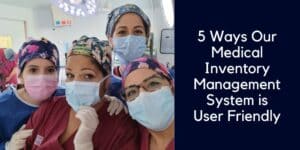It’s time to stop losing orthopedic utilization data at the POU.
Ask any orthopedic nurse – tracking, locating and then documenting the orthopedic hospital inventory used in surgery, is just one challenge after another.
Pre surgery tasks include the collation of hundreds of individual orthopedic medical inventory supplies often in kits, as well as separate medical devices, tissues, implants and small consumables. Nurses need to ensure that all the appropriate item types and sizes are available for the orthopedic procedure.
Only a fraction of the items prepared will be used during surgery, and it is then the nurse’s job to document exactly what was consumed.
Yet despite internal pressures and external regulations, recording full utilization in surgery is not always achieved – in some organizations the item usage documentation rate can be as low as 50%.
Failure to document high value implants tracking can have serious operational and clinical consequences.
So, why is it that the medical inventory used in orthopedic procedures is so hard to document?
This article will review the challenges faced by Circulating Nurses in orthopedic procedure rooms, and explain why recording utilization so often fails.
It’s clear that orthopedic surgical spaces desperately need better POU data capture tools and technology to improve efficiency – so we’ll also look at how AI technology is now being used to achieve accurate charting that safeguards patients, improves inventory management and facilitates full billing.
Orthopedic Physicians and the need to be prepared
Orthopedic procedure rooms have their own unique philosophy, and operate in a very specific way.
There is this whole ethos of expecting the unexpected, and being ready for any eventuality.
Orthopedic Physicians can be compared to boy scouts – they like to be prepared!
Orthopedic Physician Preference Items (PPI)
Orthopedic Physician Preference Items (PPI) typically include a broad selection of medical devices, tissues, implants and consumables, which come in different configurations and sizes. These may take the form of individual inventory items or a kit. Items could be stock items, just-in-time deliveries or trunk stock.
The comprehensive choice of orthopedic inventory that the nurse prepares prior to surgery allows the physician to select the most appropriate item type and size during surgery.
But there’s a price to pay for this culture of playing safe and preparing for any possibility.
Recording utilization during orthopedic surgery
Due to the wide range of medical inventory brought into orthopedic procedures, there are often documentation challenges at the point of care.
Inventory used could be:
- Hospital stock with a barcode or RFID tag: After scanning, these hospital inventory items may end up fully documented, partially documented or not documented at all – necessitating manual keying-in to ensure full digital recording in the ERP/EMR.
- Trunk stock items arrive straight from the vendor, so are not recorded in the hospital’s ‘source of truth’ – these products will require loading into the hospital system before usage can be logged.
- Orthopedic Kits, where only a percentage of the individual items provided will be consumed – these will be logged on a surgical count sheet, and every item will then require keying-in to the hospital system to be digitally captured.
- Surgical Supplies without any barcode or RFID label will all need to be manually entered.
The complexity and high volume of orthopedic medical inventory, as well as the failure of POU data collection tools, puts an admin burden on busy nurses and increases the likelihood of non-documentation at the point of care.
It’s not just the wide assortment of inventory that makes orthopedic procedures difficult to plan, there’s also variance in the hospital inventory choices of different orthopedic physicians – and this is an issue that is starting to attract attention.
PPI variance in orthopedic suites
Even though two physicians may be performing the same procedure, in the same hospital, their Physician Preference Items (PPI) are unlikely to be the same. Physicians tend to have favored suppliers and preferred products, so there can be large differences between the cost of the same surgery.
PPI items can account for more than 60% of a healthcare provider’s medical inventory supply chain costs, and price variances of up to 442% have been identified*1. These figures alone illustrate why there is a management-led drive for increased standardization.
Central to the identification of PPI issues is the review of accurate data, such as the cost of surgery per physician. In today’s data-savvy world, hospitals need to have a system that can provide advanced data analytics and insights.
Objective data can be used as the basis for discussions on PPI variance with physicians. This approach is helping to engage clinicians, improve standardization and reduce the cost of surgery.
Orthopedic inventory management challenges
The large range of medical supplies vendors, different types of products, and the lack of a simple, single method to capture full usage data from orthopedic procedures, presents supply chain admin challenges for busy Circulating Nurses.
The fact is, that the list of chargeable items consumed during surgery is often incomplete on the EHR – resulting in compromized patient safety, missed billing opportunities and lost income.
Orthopedic point of care clinical workflows for inventory management defy logic:
- Most ERPs rely upon barcode scanners as their preferred data capture tool.
- Yet many orthopedic procedures use supplies that cannot be scanned by barcodes alone.
Hospitals are required to log all UDI medical devices, tissues and implants, and failure to do so is a compliance issue.
Perhaps it’s time to move away from barcodes and embrace smarter technology?

Achieving a digital record of utilization during orthopedic surgery
Shrewd healthcare providers are discovering the power of computer vision and AI technology. A sophisticated, yet simple-to-use, data collection tool is proving to be a big hit in orthopedic surgical rooms.
One small device is resolving POC data capture issues overnight.
Snap & Go uses patent-protected image-recognition technology to achieve full and accurate UDI and charge capture on the EHR, ERP and MMIS.
This next generation technology captures 100% of charges and utilization.
- It doesn’t rely on barcodes or RFID tags.
- It doesn’t need the product to be on the Item Master List.
- It can even digitally record hand-completed inventory control sheets.
The nurse simply takes a quick ‘snap’ of the packet or count sheet, and the powerful combination of computer vision plus AI management software ensures that every item is identified and recorded in hospital systems.
Snap & Go digitally records ALL chargeable items used in orthopedic surgery, including stock items, consignment, trunk stock and small consumables.
The data captured is then analyzed using AI and machine learning technology to provide meaningful data analytics that support data-driven inventory management.
Snap & Go: POU data capture technology – the perfect tool for your orthopedic procedure rooms.

*1 3 things to know about physician preference items & ASCs (beckersasc.com)






